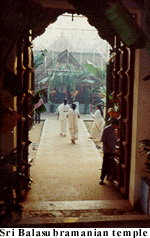|
The
day when dog rules the faith
Dogs
too have a temple for them. Ignore the eyebrows that rise at this. But
that is the unique feature of the ten-day annual Meenamaholsava at the
Ulloor Sree Balasubrahmaniya Swami Temple.
The temple complex is quite old and has Shiva, Shasta
and Krishna deities in addition to the presiding deity of Balasubrahmanya.
The legend has it that Tarakasura, during his fight with Lord Subrahmania
hid in the thick forests, now the temple premises. Lord Subrahmaniya could
not find Tarakasura, and Shasta, who had come to help his brother in the
fight, pitched in. His constant  companion
was a dog and this dog is supposed to have smelled the Asura every time
the God could not see him. And it is as veneration to this legendary dog
that the "nayaveyppu" is held every year. The "naya"(dog) is taken out
in a procession around the temple and installed in the shrine along with
the Shasta. Only that the dog looks more like a miniature of an elephant. companion
was a dog and this dog is supposed to have smelled the Asura every time
the God could not see him. And it is as veneration to this legendary dog
that the "nayaveyppu" is held every year. The "naya"(dog) is taken out
in a procession around the temple and installed in the shrine along with
the Shasta. Only that the dog looks more like a miniature of an elephant.
The festival begins with the ceremonial flag being raised
by the temple high priest. The other highlights of the ten-day festival
are the "Palliyannilavu". The deity, decked in all the finery and taken
out in a chariot around the temple three times and will be accompanied
by the traditional temple orchestra "panchavadyam". Oil lamps lights up
the whole temple complex during the pallinyannilavu procession. The "aarattu"
or the procession is held on the 9th day and offerings are made to the
deity. The festival comes to an end with the ceremonial flag being lowered.
And the devotees wait for next year for the another festival, treasured
with glowing memories of the last one. |